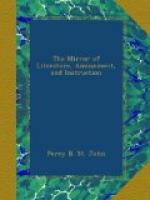WIT.
Wit is the mind’s chief judge, which
doth control.
Of Fancy’s court the judgments false
and vain,
Will holds the royal sceptre in the soul,
And on the passions of the heart doth
reign.
DAVIS.
* * * * *
THE TOPOGRAPHER.
* * * * *
TRAVELLING NOTES IN SOUTH WALES.
Gower,
Again receive me!—Let me greet
Thy “breezy hills, and soft retiring
dales”—
Thy hoary ruins, monuments of old—
Thy headlands dark, and rocks stupendous,
That battle with the elements, and fiercely,
Bound old Ocean’s empire.
History of the District of Gower, &c.
The peninsula which forms the western extremity of the county of Glamorgan is called Gower, derived from the Welsh Gwyr. The circumference of the district is about fifty miles: a slight reference to the map will explain its peculiar form better than any description we could give. The northern boundary extended east from the river Nedd, or Neath (of course including Swansea) to the Loughor, which runs into the large estuary, called the Burry River, and forms its western boundary, dividing the counties of Glamorgan and Carmarthen.
The history of Gower is interesting. It may not be out of place, however, to preface it with an outline of the history of Glamorgan. This county was conquered by the Romans, who had numerous stations in different parts, and also in the district of Gower, the traces of which still exist. Glamorgan is originally supposed to have extended from the river Tawy to Gloucester Bridge, including, besides the present county, the whole of Monmouthshire, and portions of the counties of Brecon, Hereford, and Gloucester. The Welsh princes of Glamorgan commenced paying tribute to the English in the reign of Edgar,—which was the cause of endless aggressions and disputes between them and the independent princes of North Wales, who claimed this right. The county was made a conquest about the end of the eleventh century, by Sir Robert Fitzhamon (a relation of Henry I.) whose aid had been first called in by one of the petty princes of Glamorgan, in some of the intestine feuds which agitated South Wales. Fitzhamon, after entirely defeating the Welsh, kept Cardiff Castle and the surrounding district in his own possession, and divided the rest of the county amongst twelve Norman knights, his principal followers—between whom and the inhabitants of the hills there long existed a sort of Guerilla warfare. The Normans were almost obliged to confine themselves to their castles in consequence; and the Welsh joined Owen Glendower, when he invaded Glamorgan, for which they afterwards suffered heavily. It was not till the reign of Henry VIII. that Wales became tranquillized.




